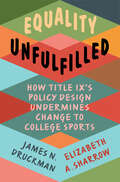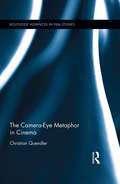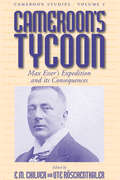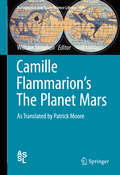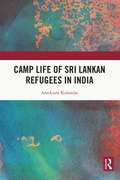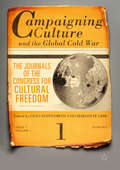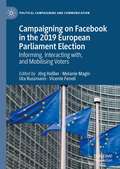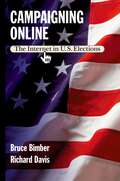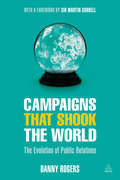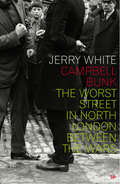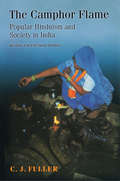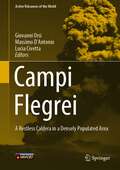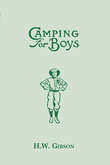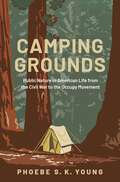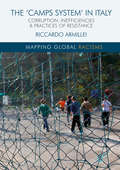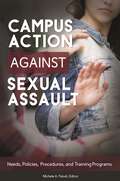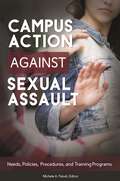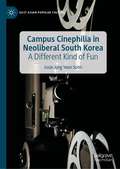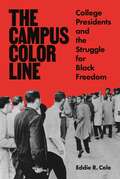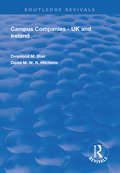- Table View
- List View
Cambridge Studies in Gender and Politics: How Title Ix's Policy Design Undermines Change To College Sports (Cambridge Studies In Gender And Politics Ser.)
by James N. Druckman Elizabeth A. SharrowThe Camera-Eye Metaphor in Cinema (Routledge Advances in Film Studies)
by Christian QuendlerThis book explores the cultural, intellectual, and artistic fascination with camera-eye metaphors in film culture of the twentieth century. By studying the very metaphor that cinema lives by, it provides a rich and insightful map of our understanding of cinema and film styles and shows how cinema shapes our understanding of the arts and media. As current new media technologies are attempting to shift the identity of cinema and moving imagery, it is hard to overstate the importance of this metaphor for our understanding of the modalities of vision. In what guises does the "camera eye" continue to survive in media that is called new?
The Camera-Eye Metaphor in Cinema (Routledge Advances in Film Studies)
by Christian QuendlerThis book explores the cultural, intellectual, and artistic fascination with camera-eye metaphors in film culture of the twentieth century. By studying the very metaphor that cinema lives by, it provides a rich and insightful map of our understanding of cinema and film styles and shows how cinema shapes our understanding of the arts and media. As current new media technologies are attempting to shift the identity of cinema and moving imagery, it is hard to overstate the importance of this metaphor for our understanding of the modalities of vision. In what guises does the "camera eye" continue to survive in media that is called new?
Camera scriptura: Die Bildschriftlichkeit der Fotografie (Szenografie & Szenologie #16)
by Ralf BohnAls Wanderer, Flaneur, Suchender, dem Zufall ausgesetzt und doch einer Geschichte folgend - so inszeniert sich der Fotograf als Retter des vergehenden Augenblicks im vergegenwärtigenden Bild. Der in diesem Band aufgearbeitete Diskurs über das Fotografische versucht, den Moment des Fotografierens und den der Bildbetrachtung als Schriftlichkeit, Verräumlichung und Inszenierung auszulegen. Das Fotografische wird zur Allegorie widerstreitender Zeitlichkeit: Rettung des Augenblicks im Bild und Einsicht in die Vergänglichkeit. Nur im bildbegleitenden Schreiben ist dieser Widerstreit erträglich. Unter dem Begriff »Bildschriftlichkeit« wird die Präsenz- und Zeitproblematik des Aufschreibesystems Fotografie mit zahlreichen Zitaten von Derrida, Benjamin, Barthes, Sontag, Flusser, Virilio, Baudrillard, Krauss, aber auch Luhmann, Heidegger und anderen belegt und kommentiert. In einem Essay des Autors werden diese Äußerungen über das Fotografische zu einem gangbaren Weg verbunden.
Cameroon's Tycoon: Max Esser's Expedition and its Consequences (Cameroon Studies #3)
by E. M. Chilver Ute RöschenthalerMax Esser was an adventurous young merchant banker, a Rhinelander, who became the first managing director of the largest German plantation company in Cameroon. This volume gives a vivid account of the antecedents and early stages as experienced and described by Esser. In 1896 he ventured, with the explorer Zintgraff, into the hinterland to seek the agreement of Zintgraff's old ally, the ruler of Bali, for the provision of laborers for his projected enterprise. The consequences, many optimistically unforeseen, are illustrated with the help of contemporary materials. Esser's account is preceded by a look at his and his family's connections, added to by an account of newspaper campaigns against him, and completed by an examination of his Cameroon collection, which he gave to the Linden Museum in Stuttgart.
Camille Flammarion's The Planet Mars: As Translated by Patrick Moore (Astrophysics and Space Science Library #409)
by Camille FlammarionCamille Flammarion (1842-1925) began his career at 16 as a human computer under the great mathematician U. J. J. Le Verrier at the Paris Observatory. He soon tired of the drudgery; he was drawn to more romantic vistas, and at 19 wrote a book on an idea that he was to make his own—the habitability of other worlds. There followed a career as France’s greatest popularizer of astronomy, with over 60 titles to his credit. An admirer granted him a chateau at Juvisy-sur-l’Orge, and he set up a first-rate observatory dedicated to the study of the planet Mars. Finally, in 1892, he published his masterpiece, La Planete Mars et ses conditions d’habitabilite, a comprehensive summary of three centuries’ worth of literature on Mars, much of it based on his own personal research into rare memoirs and archives. As a history of that era, it has never been surpassed, and remains one of a handful of indispensable books on the red planet.Sir Patrick Moore (1923-2012) needs no introduction; his record of popularizing astronomy in Britain in the 20th century equaled Flammarion’s in France in the 19th century. Moore pounded out hundreds of books as well as served as presenter of the BBC’s TV program “Sky at Night” program for 55 years (a world record). Though Moore always insisted that the Moon was his chef-d’oeuvre, Mars came a close second, and in 1980 he produced a typescript of Flammarion’s classic. Unfortunately, even he found the project too daunting for his publishers and passed the torch of keeping the project alive to a friend, the amateur astronomer and author William Sheehan, in 1993. Widely regarded as a leading historian of the planet Mars, Sheehan has not only meticulously compared and corrected Moore’s manuscript against Flammarion’s original so as to produce an authoritative text, he has added an important introduction showing the book’s significance in the history of Mars studies. Here results a book that remains an invaluable resource and is also a literary tour-de-force, in which the inimitable style of Flammarion has been rendered in the equally unique style of Moore.
The Camp, Housing, and the City: Berlin's Migrant Camp Accommodation after the »Long Summer of Migration« (Urban Studies)
by Christian SowaIn 2015 many camps were opened to accommodate newly arriving migrants in Berlin. Christian Sowa studies this form of accommodation. Moving beyond an exclusive focus on borders and migration, he argues that camp accommodation must be thought of and studied as part of the urban context and as a specific form of housing. The study provides an in-depth case study, discusses policy alternatives, argues for »housing for all instead of camps«, and contributes to bringing urban and migration studies into public discussion. In times of new waves of migration, the topic of migrant accommodation within urban environments remains highly relevant today.
Camp Life of Sri Lankan Refugees in India
by Arockiam Kulandai R. ShankarThis book looks at the mass migration of refugees into India during the Sri Lankan civil war, the lives of the displaced people in refugee camps and the politics around the issue. It analyses the citizenship policies in India and the social, economic, psychological, political and legal implications of the laws on the lives of Tamil refugees. The book examines the protracted refugee situations in other parts of the globe to build a comparative case study of the Sri Lankan refugees. It delves into the stories and lives of these people in their home country before the war, the crisis and trauma of war, and the experience of living in refugee camps. The volume looks at the role played by the state government of Tamil Nadu, the Indian government and NGOs towards the protection of these refugees and state of facilities for health, safety, education, among others in the camps. It also discusses the possibility of integration and solutions like voluntary repatriation or the granting of citizenship for the people living in these camps. This book will be a useful resource for scholars and researchers of refugee and border studies, human rights, political studies, international relations, political sociology, peace and conflict studies, war and strategic studies, and South Asian studies.
Camp Life of Sri Lankan Refugees in India
by Arockiam Kulandai R. ShankarThis book looks at the mass migration of refugees into India during the Sri Lankan civil war, the lives of the displaced people in refugee camps and the politics around the issue. It analyses the citizenship policies in India and the social, economic, psychological, political and legal implications of the laws on the lives of Tamil refugees. The book examines the protracted refugee situations in other parts of the globe to build a comparative case study of the Sri Lankan refugees. It delves into the stories and lives of these people in their home country before the war, the crisis and trauma of war, and the experience of living in refugee camps. The volume looks at the role played by the state government of Tamil Nadu, the Indian government and NGOs towards the protection of these refugees and state of facilities for health, safety, education, among others in the camps. It also discusses the possibility of integration and solutions like voluntary repatriation or the granting of citizenship for the people living in these camps. This book will be a useful resource for scholars and researchers of refugee and border studies, human rights, political studies, international relations, political sociology, peace and conflict studies, war and strategic studies, and South Asian studies.
Campaigning Culture and the Global Cold War: The Journals of the Congress for Cultural Freedom
by Giles Scott-Smith Charlotte A. LergThis book explores the lasting legacy of the controversial project by the Congress for Cultural Freedom, funded by the CIA, to promote Western culture and liberal values in the battle of ideas with global Communism during the Cold War. One of the most important elements of this campaign was a series of journals published around the world: Encounter, Preuves, Quest, Mundo Nuevo, and many others, involving many of the most famous intellectuals to promote a global intellectual community. Some of them, such as Minerva and China Quarterly, are still going to this day. This study examines when and why these journals were founded, who ran them, and how we should understand their cultural message in relation to the secret patron that paid the bills.
Campaigning on Facebook in the 2019 European Parliament Election: Informing, Interacting with, and Mobilising Voters (Political Campaigning and Communication)
by Jörg Haßler Melanie Magin Uta Russmann Vicente FenollThis book investigates how political parties from 12 European countries used Facebook to inform, interact with and mobilise voters at the 2019 European Parliament election. Following a joint theoretical framework and method, the results of a content analysis of more than 14,000 Facebook posts are presented. Country specific chapters are followed by analyses of European parties’ Facebook campaigning, the spread of populism and the use of Facebook ads by the parties. The final chapter compares all countries showing that campaigns are more strongly shaped by the national than by the European political context. Facebook is used for campaigning as usual; parties inform and persuade but neglect the platform’s mobilisation and particularly interactive affordances.
Campaigning Online: The Internet in U.S. Elections
by Bruce Bimber Richard DavisAfter a self-assured John F. Kennedy bested a visibly shaky Richard Nixon in their famous 1960 debates, political television, it was said, would henceforth determine elections. Today, many claim the Internet will be the latest medium to revolutionize electoral politics. Candidates invest heavily in web and email campaigns to reach prospective voters, as well as to communicate with journalists, potential donors, and political activists. Do these efforts influence voters, expand democracy, increase the coverage of political issues, or mobilize a shrinking and apathetic electorate? Campaigning Online answers these questions by looking at how candidates present themselves online and how voters respond to their efforts-including whether voters learn from candidates' websites and whether voters' views are affected by what they see. Although the Internet will not lead to a revolution in democracy, it will, Bimber and Davis argue, have consequences: reinforcing messages, mobilizing activists, and strengthening partisans' views. Reporting on a wealth of new data drawn from national and state-wide surveys, laboratory experiments, interviews with campaign staff, and analysis of web sites themselves, Campaigning Online draws the most complete picture of the role of campaign websites in American elections to date.
Campaigns that Shook the World: The Evolution of Public Relations
by Danny RogersCampaigns that Shook the World provides the inside story on a selection of the greatest campaigns of the last four decades, while narrating the development of the PR and communications business. The book provides the definitive case studies of nine campaigns - political, corporate and entertainment - from the 1970s to the present day. It explains their strategies and tactics, looks at the imagery and icons they created and interviews the powerful, flamboyant personalities who crafted and executed these seminal projects.The book examines Thatcherism, New Labour, Britain's royal family, the Rolling Stones, David Beckham, the London 2012 Olympics, Product (RED), Obama for America and Dove's Campaign for Real Beauty. In addition, Campaigns that Shook the World:- contains exclusive interviews with campaign gurus such as Alastair Campbell, Matthew Freud, Simon Fuller and Lord Tim Bell- investigates the relationship between communication techniques, the media and evolving public opinion, using real-world examples- features campaigns by Saatchi & Saatchi, Edelman, Bell Pottinger, Ogilvy, Freuds and other well-known marketing consultanciesCampaigns that Shook the World grapples with PR's uneasy place at the nexus of politics and celebrity, holding the best campaigns up to scrutiny and showcasing just how powerful PR can be as an instrument of change. It contains insights from Alan Edwards, Paddy Harverson and many others.
Campbell Bunk: The Worst Street in North London Between the Wars
by Jerry WhiteFrom the 1880s to the Second World War, Campbell Road, Finsbury Park (known as Campbell Bunk), had a notorious reputation for violence, for breeding thieves and prostitutes, and for an enthusiastic disregard for law and order. It was the object of reform by church, magistrates, local authorities, and social scientists, who left many traces of their attempts to improve what became known as 'the worst street in North London'. Jerry White offers insight into the realities of life in a 'slum' community, showing how it changed over a 90-year period. Using extensive oral history to describe in detail the years between the wars, White reveals the complex tensions between the new world opening up and the street's traditional culture of economic individualism, crime, street theatre, and domestic violence.
The Camphor Flame: Popular Hinduism and Society in India - Revised and Expanded Edition (PDF)
by C. J. FullerPopular Hinduism is shaped, above all, by worship of a multitude of powerful divine beings--a superabundance indicated by the proverbial total of 330 million gods and goddesses. The fluid relationship between these beings and humans is a central theme of this rich and accessible study of popular Hinduism in the context of the society of contemporary India. Lucidly organized and skillfully written, The Camphor Flame brings clarity to an immensely complicated subject. C. J. Fuller combines ethnographic case studies with comparative anthropological analysis and draws on textual and historical scholarship as well. The book's new afterword brings the study up-to-date by examining the relationship between popular Hinduism and contemporary Hindu nationalism.
Campi Flegrei: A Restless Caldera in a Densely Populated Area (Active Volcanoes of the World)
by Giovanni Orsi Massimo D’Antonio Lucia CivettaThe densely populated Campi Flegrei resurgent caldera is one of the widest known, best studied and highly dangerous volcanoes of the world. This monograph synthesises the current knowledge of this volcano, through different review chapters. Each chapter of this book is dedicated to a specific volcanological aspect, authored by well-recognised experts. The volume attempts to cross the barriers between the volcanological, geological, geochemical and geophysical perspectives, and offers a comprehensive and up-to-date reference to earth-science scholars, as well as land planners and civil defence officers.
Camping for Boys
by H W GibsonDo you know how to make a camp bed, test the freshness of an egg or light a match when there is nothing to strike it on? From setting up camp to choosing a motto, treating blisters to making a bow and arrow, Camping for Boys will ensure a happy, healthy time is had by all when out of doors. First published in 1913 in an era before televisions and video games, Camping for Boys was an indispensable guide for any young boy wanting to make the most of the great outdoors. With sections on games for a rainy day, first aid, cooking, building and maintaining the campfire, nature study, forecasting the weather, building a hygienic camp toilet, organisation, leadership and discipline, this valuable little book will help big kids to regain their youth and experience the thrill of the wind in their hair. Also suitable for armchair campers.
Camping Grounds: Public Nature in American Life from the Civil War to the Occupy Movement
by Phoebe S.K. YoungAn exploration of the hidden history of camping in American life that connects a familiar recreational pastime to camps for functional needs and political purposes. Camping appears to be a simple proposition, a time-honored way of getting away from it all. Pack up the car and hit the road in search of a shady spot in the great outdoors. For a modest fee, reserve the basic infrastructure--a picnic table, a parking spot, and a place to build a fire. Pitch the tent and unroll the sleeping bags. Sit under the stars with friends or family and roast some marshmallows. This book reveals that, for all its appeal, the simplicity of camping is deceptive, its history and meanings far from obvious. Why do some Americans find pleasure in sleeping outside, particularly when so many others, past and present, have had to do so for reasons other than recreation? Never only a vacation choice, camping has been something people do out of dire necessity and as a tactic of political protest. Yet the dominant interpretation of camping as a modern recreational ideal has obscured the connections to these other roles. A closer look at the history of camping since the Civil War reveals a deeper significance of this American tradition and its links to core beliefs about nature and national belonging. Camping Grounds rediscovers unexpected and interwoven histories of sleeping outside. It uses extensive research to trace surprising links between veterans, tramps, John Muir, African American freedpeople, Indian communities, and early leisure campers in the nineteenth century; tin-can tourists, federal campground designers, Depression-era transients, family campers, backpacking enthusiasts, and political activists in the twentieth century; and the crisis of the unsheltered and the tent-based Occupy Movement in the twenty-first. These entwined stories show how Americans camp to claim a place in the American republic and why the outdoors is critical to how we relate to nature, the nation, and each other.
Camping Grounds: Public Nature in American Life from the Civil War to the Occupy Movement
by Phoebe S.K. YoungAn exploration of the hidden history of camping in American life that connects a familiar recreational pastime to camps for functional needs and political purposes. Camping appears to be a simple proposition, a time-honored way of getting away from it all. Pack up the car and hit the road in search of a shady spot in the great outdoors. For a modest fee, reserve the basic infrastructure--a picnic table, a parking spot, and a place to build a fire. Pitch the tent and unroll the sleeping bags. Sit under the stars with friends or family and roast some marshmallows. This book reveals that, for all its appeal, the simplicity of camping is deceptive, its history and meanings far from obvious. Why do some Americans find pleasure in sleeping outside, particularly when so many others, past and present, have had to do so for reasons other than recreation? Never only a vacation choice, camping has been something people do out of dire necessity and as a tactic of political protest. Yet the dominant interpretation of camping as a modern recreational ideal has obscured the connections to these other roles. A closer look at the history of camping since the Civil War reveals a deeper significance of this American tradition and its links to core beliefs about nature and national belonging. Camping Grounds rediscovers unexpected and interwoven histories of sleeping outside. It uses extensive research to trace surprising links between veterans, tramps, John Muir, African American freedpeople, Indian communities, and early leisure campers in the nineteenth century; tin-can tourists, federal campground designers, Depression-era transients, family campers, backpacking enthusiasts, and political activists in the twentieth century; and the crisis of the unsheltered and the tent-based Occupy Movement in the twenty-first. These entwined stories show how Americans camp to claim a place in the American republic and why the outdoors is critical to how we relate to nature, the nation, and each other.
The ‘Camps System’ in Italy: Corruption, Inefficiencies and Practices of Resistance (Mapping Global Racisms)
by Riccardo ArmilleiThis book deals with the social exclusion of Romanies (‘Gypsies’) in Italy. Based on interviews with Romani individuals, institutional and Civil Society Organisations’ (CSOs) representatives, participant observation and a broad range of secondary sources, the volume focuses on the conditions of those living in Rome’s urban slums and on the recent implementation of the so-called ‘Emergenza Nomadi’ (Nomad Emergency). The enactment of this extraordinary measure concealed the existence of a long-established institutional tradition of racism and control directed at Romanies. It was not the result of a sudden, unexpected situation which required an immediate action, as the declaration of an ‘emergency’ might imply, but rather of a precise government strategy. By providing an investigation into the interactions between Romanies, local institutions and CSOs, this book will deliver a new perspective on the Romani issue by arguing that the ‘camp’ is not only a tool for institutional control and segregation, but also for ‘resistance’, as well as a huge business in which everyone plays their part.
Campus Action against Sexual Assault: Needs, Policies, Procedures, and Training Programs (Women's Psychology)
by Michele A. PaludiA practical guide to prevention of and response to sexual assault on college campuses, this invaluable resource will help ensure Title IX compliance—and can also help reduce the incidence of these all-too-prevalent events.The frequency of sexual assault on college campuses is startlingly high. Notwithstanding this fact, most campus officials are not trained in the psychology of the victimization process, while most students are not aware of their reporting options. A practical guide to sexual assault at colleges and universities, this book integrates theories and empirical research with information about legislation and techniques to help college administrators deal with—and prevent—these disturbing offenses. The work brings together a team of experts who discuss various types of assault, including rape, stalking, intimate partner violence, and sexual harassment, and detail the legal, educational, and federal responses to such events on college campuses. They address federal and state laws, including new bills being proposed in Congress, and present research on the physical and psychological dimensions of sexual assault. Perhaps most important, the book shows how human resource techniques and principles can be used to establish preventative measures and to respond appropriately when sexual assault does occur. Students' accounts of prevention training and education enhance the scholarly and legal contributions to this important—and timely—volume.
Campus Action against Sexual Assault: Needs, Policies, Procedures, and Training Programs (Women's Psychology)
by Michele A. PaludiA practical guide to prevention of and response to sexual assault on college campuses, this invaluable resource will help ensure Title IX compliance—and can also help reduce the incidence of these all-too-prevalent events.The frequency of sexual assault on college campuses is startlingly high. Notwithstanding this fact, most campus officials are not trained in the psychology of the victimization process, while most students are not aware of their reporting options. A practical guide to sexual assault at colleges and universities, this book integrates theories and empirical research with information about legislation and techniques to help college administrators deal with—and prevent—these disturbing offenses. The work brings together a team of experts who discuss various types of assault, including rape, stalking, intimate partner violence, and sexual harassment, and detail the legal, educational, and federal responses to such events on college campuses. They address federal and state laws, including new bills being proposed in Congress, and present research on the physical and psychological dimensions of sexual assault. Perhaps most important, the book shows how human resource techniques and principles can be used to establish preventative measures and to respond appropriately when sexual assault does occur. Students' accounts of prevention training and education enhance the scholarly and legal contributions to this important—and timely—volume.
Campus Cinephilia in Neoliberal South Korea: A Different Kind of Fun (East Asian Popular Culture)
by Josie Jung SohnTaking a transnational approach to the study of film culture, this book draws on ethnographic fieldwork in a South Korean university film club to explore a cosmopolitan cinephile subculture that thrived in an ironic unevenness between the highly nationalistic mood of commercial film culture and the intense neoliberal milieu of the 2000s. As these time-poor students devoted themselves to the study of film that is unlikely to help them in the job market, they experienced what a student described as ‘a different kind of fun’, while they appreciated their voracious consumption of international art films as a very private matter at a time of unprecedented boom in the domestic film industry. This unexpectedly vibrant cosmopolitan subculture of student cinephiles in neoliberal South Korea makes the nation’s film culture more complex and interesting than a simple nationalistic affair.
The Campus Color Line: College Presidents and the Struggle for Black Freedom
by Eddie R. Cole"A stunning and ambitious origins story."—Ibram X. Kendi, National Book Award–winning and #1 New York Times–bestselling authorThe remarkable history of how college presidents shaped the struggle for racial equalitySome of America’s most pressing civil rights issues—desegregation, equal educational and employment opportunities, housing discrimination, and free speech—have been closely intertwined with higher education institutions. Although it is commonly known that college students and other activists, as well as politicians, actively participated in the fight for and against civil rights in the middle decades of the twentieth century, historical accounts have not adequately focused on the roles that the nation’s college presidents played in the debates concerning racism. Based on archival research conducted at a range of colleges and universities across the United States, The Campus Color Line sheds light on the important place of college presidents in the struggle for racial parity.Focusing on the period between 1948 and 1968, Eddie Cole shows how college presidents, during a time of violence and unrest, strategically, yet often silently, initiated and shaped racial policies and practices inside and outside of the educational sphere. With courage and hope, as well as malice and cruelty, college presidents positioned themselves—sometimes precariously—amid conflicting interests and demands. Black college presidents challenged racist policies as their students demonstrated in the streets against segregation, while presidents of major universities lobbied for urban renewal programs that displaced Black communities near campus. Some presidents amended campus speech practices to accommodate white supremacist speakers, even as other academic leaders developed the nation’s first affirmative action programs in higher education.The Campus Color Line illuminates how the legacy of academic leaders’ actions continues to influence the unfinished struggle for Black freedom and racial equity in education and beyond.
Campus Companies: UK and Ireland (Routledge Revivals)
by Desmond M. Blair David M.W.N. HitchensFirst published in 1998, this volume explored the recent growth in university-based commercial start-up companies as a means of applying research in industry and as an alternative method of funding. Blair and Hitchens melded the practical experiences of universities with more theoretical understandings of technology transfer to assess whether it is more effective for universities to make commercial use of their research themselves as opposed to licensing, whether this is an effective way to get research applied by industry and the economic implications of these decisions. Drawing on the experiences of 25 universities, of which 18 are in the UK and Ireland, and including a detailed study of the QUBIS Group from Queen’s University of Belfast, the authors explore universities’ deliberate commercial exploitation of their research through university spin-off companies, the potential stresses on staff who are simultaneously academics and entrepreneurs along with universities’ attitudes to the practice and possible managerial strategies.
